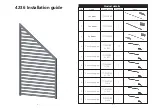
26
Operation and control
5.5
Loading the test chamber
Warning!
When loading the chamber with an unsuitable load, toxic or explo-
sive vapours or gases may be produced. This could cause the cham-
ber to explode, and people could be badly injured or poisoned. The
chamber may only be loaded with materials/test objects which do
not form any toxic or explosive vapours when heated up and cannot
ignite (see also chapter 2.6 Intended Use on page 14 ). If there is any
doubt as to the composition of materials, they must not be loaded
into the test chamber.
Caution:
Check the chamber load for chemical compatibility with the materials of the test cham-
ber (see page 14 ).
When operating the chamber with a chamber load which itself emits heat to the interior, dis-
able the automatic defrosting system (see page 54 and chapter 7.2 Basic appliance settings
(Setup) on page 46 ).
Insert sliding grate(s). (One sliding grate is included in the standard delivery.)
The chamber must not be loaded too tightly, so that proper air circulation in the working
chamber is guaranteed. Do not place any of the chamber load on the floor, touching the side
walls or right below the ceiling of the working chamber.
The maximum number and load capacity of the sliding shelves can be found in the table in
chapter 2.9 Technical data on page 17 . If the load is set up unfavourably (too close together) it
may take longer than normal to reach the set temperature under certain circumstances.
For test samples which require wires during the
test (for power supply or for measuring
purposes), the test chamber is equipped with a
cable feed-through on the right-hand side ( Fig.
18 , see also page 10 ).
Pull out the silicone plugs if they are plugged
in ( Fig. 18 ), and push the wires into the interior
of the chamber. Then re-insert the plugs and
press them tight, so that no heat/humidity can
escape from inside the chamber through the
feed-through.
Fig. 18
Cable feed-through with plugs
in the right-hand side of the appliance
















































